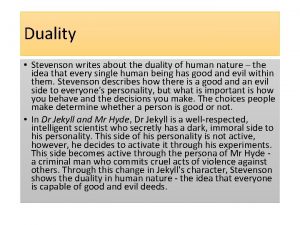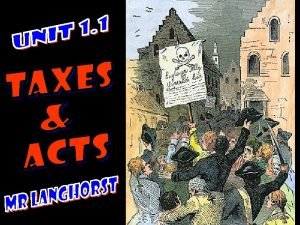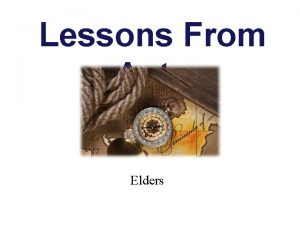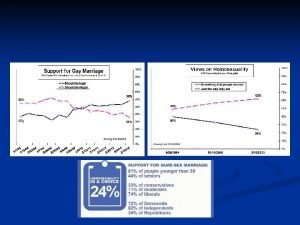Construction of Homosexuality Why Construction A homosexual acts












- Slides: 12

Construction of Homosexuality

Why “Construction”? A. homosexual acts are a constant in history, but not their social significance B. a given society may (or may not) “construct” roles and identities related to sexual behavior C. In the 19 th century, the idea of deviance is constructed for homosexuals

Sodomy law in the English Context A. Variations in enforcement 1. sometimes strictly enforced with death penalty until the 1840 s. 2. especially in the military and in times of war 3. based on acts, not behavior B. No scientific or forensic theory of homosexuality 1. in sodomy cases up to the 1870 s, police have no idea of a homosexual type or lifestyle 2. common idea was some men were bisexual

From “sodomite” to “homosexual” A. sodomite referred to someone who committed certain acts; a homosexual was category of person 1. defined by medicine, psychology and law 2. Change in consciousness of society and of homosexuals themselves B. Legal changes 1. Law in 1861 removes death penalty for buggery, 2. distinguishing between different sorts of buggery 3. Criminal Law Amendment of 1885 made “gross indecency” a misdemeanor up to two years of prison 4. reliance on moral rather than punitive discipline

From “sodomite” to “homosexual” C. Genesis of the Criminal Law Amendment Act (1885) 1. “social purity” movement against male lust 2. born in fight against Contagious Diseases Acts (1869) 3. sexual/physical purity connected to moral strength 4. Prevent corruption of the youth, and defend marriage and gender system of domesticity

From “sodomite” to “homosexual” D. The significance of Labouchere’s amendment against “gross indecency” 1. designed to suppress male prostitution 2. less repressive than sodomy law 3. but harsher penalties than for female prostitutes or male customers, and more strictly enforced 4. reflects moral outrage at deviant lifestyle

The Effect of the Wilde Trial A. Oscar Wilde trial establishes the public image of the homosexual personality or “invert” 1. flamboyant, aesthetical, otherwise different from the “bourgeois philistine”


The Effect of the Wilde Trial A. Oscar Wilde trial establishes the public image of the homosexual personality or “invert” 1. flamboyant, aesthetical, otherwise different from the “bourgeois philistine” 2. physical and moral weakness connected 3. connected to the general fears for masculine degeneracy (see Forth, chapter 6)



The Effect of the Wilde Trial B. Trial is public attack on homosexual personality 1. Wilde is a symbol, and he stands up for himself 2. inspires homosexuals to make a stand for themselves 3. they begin to see themselves as a different sort of person; a new sense of identity emerges
 Toc homosexual
Toc homosexual Duality quotes
Duality quotes Homosexuality
Homosexuality Why why why why
Why why why why Dont ask
Dont ask 5 modifiers of human act
5 modifiers of human act Why did the colonists hate the proclamation of 1763
Why did the colonists hate the proclamation of 1763 External forms of social control
External forms of social control Why is theory construction a major feature of science
Why is theory construction a major feature of science Why-why analysis
Why-why analysis Why do you cry willie why do you cry
Why do you cry willie why do you cry Does this table represent a function why or why not
Does this table represent a function why or why not What does the image represent
What does the image represent























